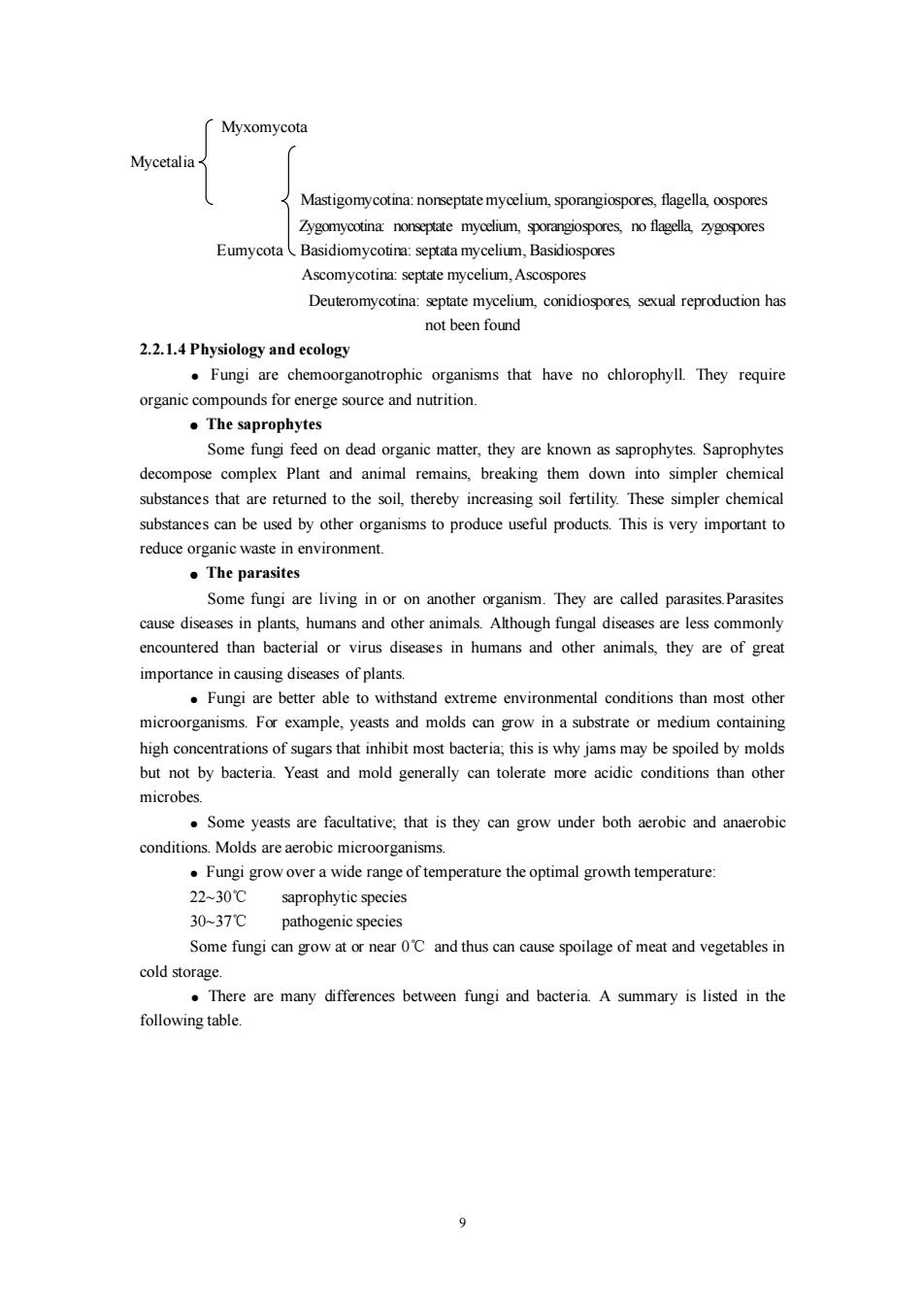正在加载图片...

9 Myxomycota Mastigomycotina: nonseptate mycelium, sporangiospores, flagella, oospores Zygomycotina: nonseptate mycelium, sporangiospores, no flagella, zygospores Eumycota Basidiomycotina: septata mycelium, Basidiospores Ascomycotina: septate mycelium, Ascospores Deuteromycotina: septate mycelium, conidiospores, sexual reproduction has not been found 2.2.1.4 Physiology and ecology ● Fungi are chemoorganotrophic organisms that have no chlorophyll. They require organic compounds for energe source and nutrition. ● The saprophytes Some fungi feed on dead organic matter, they are known as saprophytes. Saprophytes decompose complex Plant and animal remains, breaking them down into simpler chemical substances that are returned to the soil, thereby increasing soil fertility. These simpler chemical substances can be used by other organisms to produce useful products. This is very important to reduce organic waste in environment. ● The parasites Some fungi are living in or on another organism. They are called parasites.Parasites cause diseases in plants, humans and other animals. Although fungal diseases are less commonly encountered than bacterial or virus diseases in humans and other animals, they are of great importance in causing diseases of plants. ● Fungi are better able to withstand extreme environmental conditions than most other microorganisms. For example, yeasts and molds can grow in a substrate or medium containing high concentrations of sugars that inhibit most bacteria; this is why jams may be spoiled by molds but not by bacteria. Yeast and mold generally can tolerate more acidic conditions than other microbes. ● Some yeasts are facultative; that is they can grow under both aerobic and anaerobic conditions. Molds are aerobic microorganisms. ● Fungi grow over a wide range of temperature the optimal growth temperature: 22~30℃ saprophytic species 30~37℃ pathogenic species Some fungi can grow at or near 0℃ and thus can cause spoilage of meat and vegetables in cold storage. ● There are many differences between fungi and bacteria. A summary is listed in the following table. Mycetalia9 Myxomycota Mastigomycotina: nonseptate mycelium, sporangiospores, flagella, oospores Zygomycotina: nonseptate mycelium, sporangiospores, no flagella, zygospores Eumycota Basidiomycotina: septata mycelium, Basidiospores Ascomycotina: septate mycelium, Ascospores Deuteromycotina: septate mycelium, conidiospores, sexual reproduction has not been found 2.2.1.4 Physiology and ecology ● Fungi are chemoorganotrophic organisms that have no chlorophyll. They require organic compounds for energe source and nutrition. ● The saprophytes Some fungi feed on dead organic matter, they are known as saprophytes. Saprophytes decompose complex Plant and animal remains, breaking them down into simpler chemical substances that are returned to the soil, thereby increasing soil fertility. These simpler chemical substances can be used by other organisms to produce useful products. This is very important to reduce organic waste in environment. ● The parasites Some fungi are living in or on another organism. They are called parasites.Parasites cause diseases in plants, humans and other animals. Although fungal diseases are less commonly encountered than bacterial or virus diseases in humans and other animals, they are of great importance in causing diseases of plants. ● Fungi are better able to withstand extreme environmental conditions than most other microorganisms. For example, yeasts and molds can grow in a substrate or medium containing high concentrations of sugars that inhibit most bacteria; this is why jams may be spoiled by molds but not by bacteria. Yeast and mold generally can tolerate more acidic conditions than other microbes. ● Some yeasts are facultative; that is they can grow under both aerobic and anaerobic conditions. Molds are aerobic microorganisms. ● Fungi grow over a wide range of temperature the optimal growth temperature: 22~30℃ saprophytic species 30~37℃ pathogenic species Some fungi can grow at or near 0℃ and thus can cause spoilage of meat and vegetables in cold storage. ● There are many differences between fungi and bacteria. A summary is listed in the following table. Mycetalia